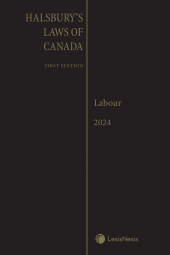Canadian Collective Bargaining Law: Principles and Practice, 3rd Edition
One Year Subscription Only Terms
Subscribers receive the product(s) listed on the Order Form and any Updates made available during the annual subscription period. Shipping and handling fees are not included in the annual price.
Subscribers are advised of the number of Updates that were made to the particular publication the prior year. The number of Updates may vary due to developments in the law and other publishing issues, but subscribers may use this as a rough estimate of future shipments. Subscribers may call Customer Support at 800-833-9844 for additional information.
Subscribers may cancel this subscription by: calling Customer Support at 800-833-9844; emailing customer.support@lexisnexis.com; or returning the invoice marked 'CANCEL'.
If subscribers cancel within 30 days after the product is ordered or received and return the product at their expense, then they will receive a full credit of the price for the annual subscription.
If subscribers cancel between 31 and 60 days after the invoice date and return the product at their expense, then they will receive a 5/6th credit of the price for the annual subscription. No credit will be given for cancellations more than 60 days after the invoice date. To receive any credit, subscriber must return all product(s) shipped during the year at their expense within the applicable cancellation period listed above.
Product description
The law of collective bargaining is one of the most sophisticated and dynamic areas of law in Canada. Every practitioner should have a "go to" text on the framework in this area of the law and the process of collective bargaining, as well as practicalities to consider. The third edition of this highly regarded resource includes relevant updates to case law and statutes throughout; it also has been significantly expanded to include an entire new part of the text, which features 11 new chapters that examine the practical aspects of the collective bargaining process.
The Framework
The first part of the text guides the reader through the foundational topics of collective bargaining :
- Sets out the historical, economic, and philosophical context within which the law operates
- Introduces the reader to the major public players on the collective bargaining stage, as well as private players
- Clarifies the origin and lifespan of a union's bargaining rights
- Analyzes the game-changing rulings of the Supreme Court of Canada on Charter issues that have arisen in the labour law context
- Includes major legislative changes since the last edition
- Examines the collective agreement and key clauses
- Examines the use of economic sanctions and the restrictions that the law places on economic warfare
- Analyzes the rules governing internal union affairs, and most importantly, the relationship of the union member to his or her union
The Process – 11 New Chapters
The second part of the text guides the reader through the chronology of the collective bargaining process :
- Considers how collective bargaining should be approached and what preparations are recommended
- Looks at the ongoing nature of collective bargaining, sometimes starting even before the current agreement is ratified
- Reviews special forms of bargaining and special sectors of the economy within which bargaining occurs
- Examines the advantages and impact of a collective agreement and how that may translate into the many workplaces that operate without a formal agreement, which may be of particular interest to non-unionized workplaces
- Looks at the broader impact of the collective bargaining experience on Canadian workplaces and legislation
- Considers some exploratory musings on how our collective bargaining laws shape us as a society and what the future might look like
New In This Edition
- New section on the statutory framework which explains the different types of statutes that govern collective bargaining and, specifically, the contents of collective agreements
- Updates to the section on standard of review in light of the decision in Dunsmuir v. New Brunswick and subsequent cases clarifying the approach to determining the standard of review
- New section on conciliation / meditation and arbitration in the chapter on the negotiation of the collective agreement
- In the section on common clauses in the chapter on the collective agreement, the authors have included new sections on common clauses pertaining to additional union rights and responsibilities, classification of employees, layoff and recall, non-discrimination, contracting out, and hours of work
- Updated Concordance of Canada Labour Code Provisions Cited in the text
Of Interest To
- Labour and employment lawyers – Comprehensive explanation and discussion of the law in the area they practice
- Government lawyers, in-house counsel, labour union representatives and negotiators – Comprehensive discussion and explanation of the law which governs their organizations
- Law Libraries – For patrons to utilize for research purposes; for libraries to update their collections for said patrons
Table of contents
Chapter 1: Historical Introduction
Chapter 2: Basic Premises of Modern Labour Legislation
Chapter 3: Labour Monopoly in an International Market: Cooperation or Conflict?
Chapter 4: Labour Relations Legislation, The Charter and The Supreme Court of Canada
Chapter 5: Division of Powers
Chapter 6: The Labour Relations Board
Chapter 7: The Role of the Courts
Chapter 8: Employees
Chapter 9: Employers
Chapter 10: Unions
Chapter 11: The Right to Organize
Chapter 12: Certification
Chapter 13: Voluntary Recognition
Chapter 14: Successor Rights and Obligations
Chapter 15: Termination of Bargaining Rights
Chapter 16: Negotiation of the Agreement
Chapter 17: The Collective Agreement
Chapter 18: Arbitration to Enforce the Collective Agreement
Chapter 19: Other Procedures to Enforce the Collective Agreement
Chapter 20: Economic Warfare – Primary Activity
Chapter 21: Economic Warfare – Secondary Activity
Chapter 22: Alternatives to Economic Warfare
Chapter 23: The Legal Status of Unions
Chapter 24: The International, Parent-Local Relationships
Chapter 25: The Individual and the Union
Chapter 26: Approaches to Collective Bargaining
Chapter 27: Preparing for Collective Bargaining
Chapter 28: Initial Proposals
Chapter 29: Communications in the Internet Age
Chapter 30: Resolution, Ratification, and Return to Work
Chapter 31: Preparing for the Next Round of Collective Bargaining
Chapter 32: Continuous Bargaining
Chapter 33: Special Forms of Collective Bargaining
Chapter 34: Unique Sectors
Chapter 35: Managing With and Without a Collective Agreement
Chapter 36: Wider Impact of Collective Bargaining
 Lexis Nexis
Lexis Nexis 


